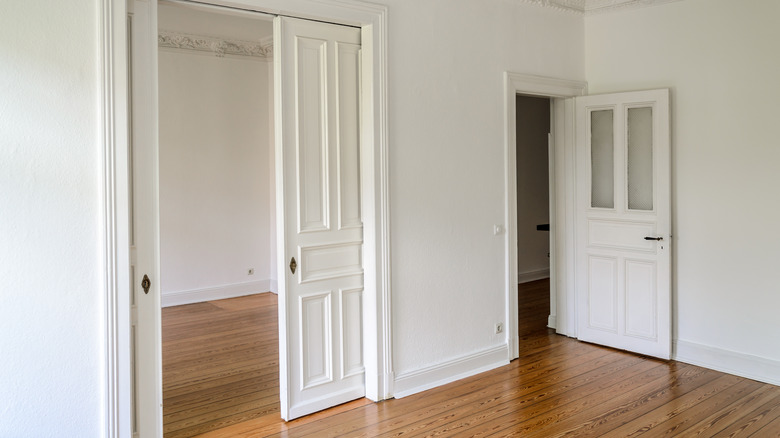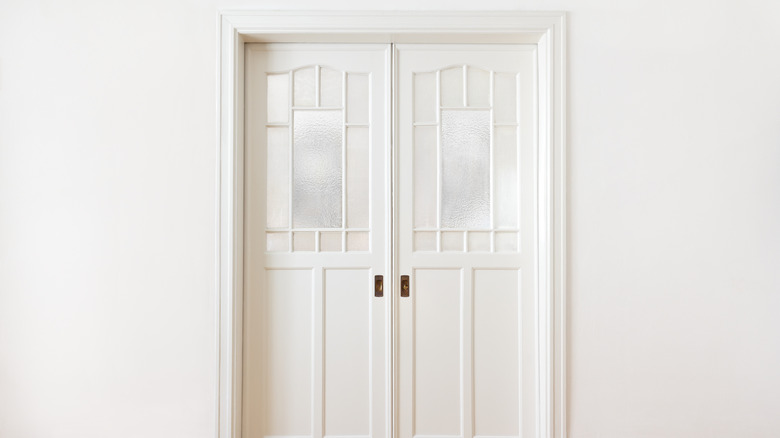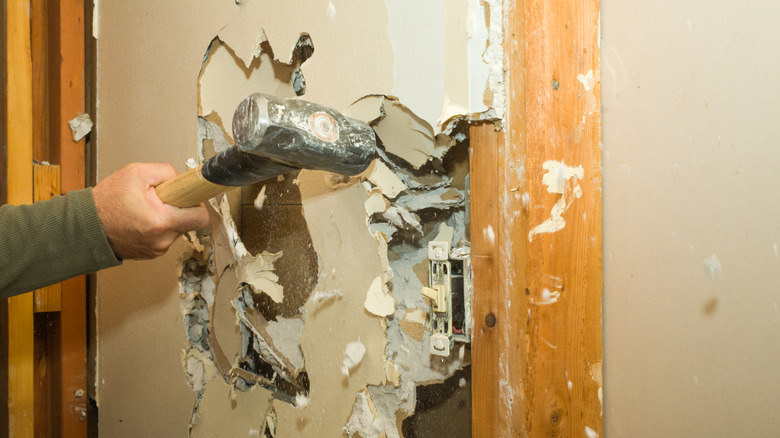Pocket Doors Can Save Space In Tight Places, But They Come With A Few Downsides
Pocket doors have long been a coveted feature in homes. This type of door makes a room feel instantly more architectural due to their popularity in lavish, historic houses, and because of the skill that is needed to design and install them. Not only do they feel more elevated and elegant than regular swinging doors, but they also save space since they disappear into the wall. This makes them a great choice for tight areas. Because of this, some of the best places in your home for a pocket door are pantries, smaller home offices, or hallways. They can also help create more privacy in your home when installed to close off connecting rooms, such as dining and living rooms. But while they come with benefits, they also have their downsides. It's important to know these drawbacks before taking the time and expense to install them.
Specifically, pocket doors aren't as reliable at holding back noise, light, or smells as regular swinging doors are. This can make them a poor choice for places you want privacy, such as bedrooms or bathrooms. While they save space, they can also be difficult to maintain. The doors can fall off the tracks or become stuck in the pockets too, making them more finicky than their swinging counterparts. These are hard to repair since they're inside of a wall cavity and might require some demolition to fix. Here is a closer look at pocket door drawbacks.
They aren't as efficient as swinging doors
While design enthusiasts can appreciate an ornamental door that takes considerable craftsmanship to create, at the end of the day, most of us want a door that performs its basic functions. And that is a door that can block sounds, smells, and light when we need it to. However, because of pocket doors' construction, they aren't as good at keeping these things out. They operate on a track, opening and closing via a wheel carrier, which means that they have larger gaps on the bottom. They also don't close as tightly as a hinged door. Instead, they tend to have a slight gap where the two doors meet when they close. These openings allow more sound and light through, which might not be ideal for places like home offices, bathrooms, or nurseries.
Pocket doors are also typically more lightweight since you have to roll them open and closed, which doesn't help with soundproofing. They need to be thinner than regular doors since they need to squeeze in between the walls, which makes them more susceptible to noise penetrating through. While older or more expensive models might have a solid wooden core — which could help dampen noise — these are harder to move, are more costly to purchase, and will wear down the tracks and wheel carriers faster due to their weight.
They can be hard to fix and clean
In addition to not being as efficient as hinged doors, they can also be a hindrance. The doors can fall off their tracks, or the plastic hardware can wear down or crack, making them difficult to open and close. If this happens, you will need to fix the inner mechanisms, but as you can imagine, they're much more difficult to get to than the hinges on regular doors. Since the hardware is hidden inside the wall, accessing it can be tricky. In worst-case scenarios, you might have to tear open drywall or remove cabinets to get to the tracks or wheel carriers.
In addition to falling off of their tracks, pocket doors can also become more burdensome to roll if the tracks get dirty. They will become clogged with built-up dust, hair, and grime when debris on the floor eventually migrates into their openings. In worst-case scenarios, pests such as mice can hide and defecate inside. However, cleaning them out isn't that simple. Since the tracks are encased in drywall, you will need to fully remove the door from its pocket casing in order to get a vacuum hose into the opening. This makes it much more cumbersome to upkeep.


